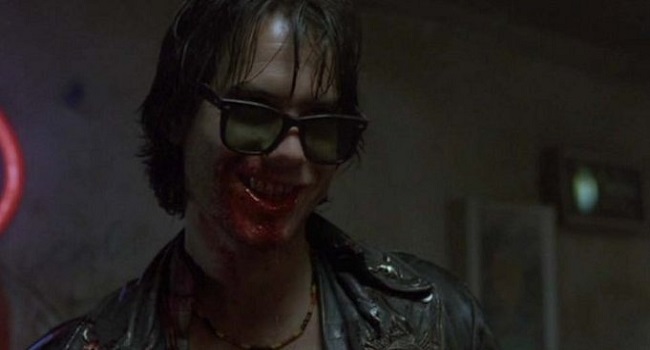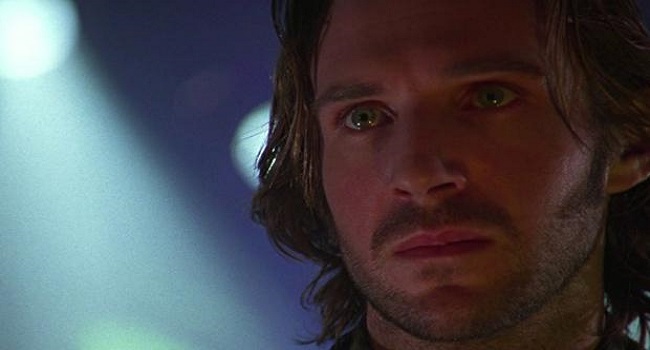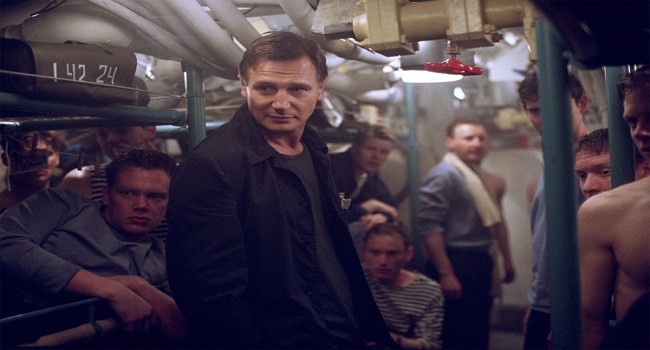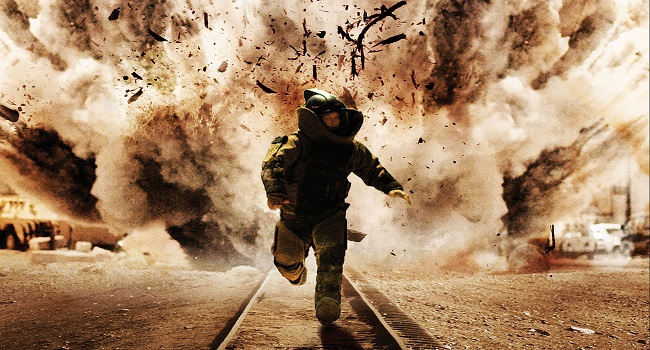Kathryn Bigelow is a woman who works within the Hollywood system yet marches to the beat of her own drum. She is the kind of filmmaker that most directors working in the action genre wish they could be. Filling her films with intense action sequences, a sense of style and compelling characters, Bigelow routinely elevates her films above many of the traditional works in the genre. In 2010, Bigelow made history when she became the first woman to win the Academy Award for Best Director for her film The Hurt Locker. Though women still struggle for equality in a film industry plagued by sexism, Bigelow is one of the few female directors who manages to have her unique voice heard.
Born on November 27, 1951 in San Carlos, California, Bigelow enrolled in the San Francisco Art Institute in 1970 to pursue her passion for painting. After receiving her Bachelor’s degree two years later, she moved to New York to attend the Whitney Museum’s Independent Art program. It was there where she met avant-garde composer Philip Glass who introduced her to the world of film. This led her to study film at Columbia University under the tutelage of such figures as Susan Sontag, Vito Acconci, Lawrence Weiner, and Sylvere Lotringer.
At Columbia University, she made her first short film, a 20-minute piece, called The Set-Up. The film centered around two men fighting each other while semioticians Sylvère Lotringer and Marshall Blonsky deconstructed images via voice-over narrations. The short managed to get the attention of director Milos Forman, who saw a lot of promise in Bigelow.
The Loveless (review)
With the assistance of some independent funding, and the collaboration of friend Monty Montgomery, Bigelow’s first feature film revolved around the world of bikers. Originally titled Breakdown, The Loveless focused on a group of bikers who, on their way to Daytona, get stranded in a remote small town in the middle of Florida. Though set in the late 1950s/early 1960s, Bigelow and Montgomery played with many of the traditional biker clichés of that era. She was more interested in exploring themes of man dealing with his place in the world rather than simply telling a tale about bikers encountering conservative locals.
The film’s cast consisted of largely unknown actors. Relative newcomer Willem Dafoe was cast in the lead role of Vance. Dafoe’s only other film appearance up to that point was an uncredited role in Michael Cimino’s notorious 1980 flop Heaven’s Gate. Rockabilly musician Robert Gordon did double duty acting in the film and helping out with the soundtrack. Though Bigelow and Montgomery shared directing duties, Bigelow visual stamp was apparent througout the film.
The Loveless premiered at the 1981 Locarno International Film Festival in Switzerland before hitting the festival circuit for the next few years. Though its theatrical release in 1984 didn’t connect with audiences or critics, The Loveless eventually received cult film status many years later. The film also helped to launch Willem Dafoe’s long and successful career. With Montgomery deciding to go producing route, most notably working with David Lynch, Bigelow spent the rest of the 80s working on various small projects.
Near Dark (review)
While trying to forge her career as a filmmaker by directing several commercials, Bigelow met James Cameron who was coming off successful films such as The Terminator and Aliens. It was around this same time that she also met writer Eric Red and decided to collaborate on a project. Their script was originally set within the western genre but they quickly realized that westerns were difficult to market to modern audiences. Instead they revamped their story and fused in elements of classic westerns into the vampire genre.
Bigelow knew that meshing the two genres wouldn’t be easy yet she was determined to stray from the typical conventions of the genre. Near Dark followed a young man who falls for a young woman who turns out to be a vampire. Bigelow infused the film with elements of horror and dark comedy which helped to give the film a unique tone. The cast included famed character actor Tim Thomerson as well as Adrian Pasdar, Jenny Wright, and Joshua John Miller. Bigelow got additional casting help from James Cameron who recommended the likes of Lance Henriksen, Jenette Goldstein, and Bill Paxton. All three actors had appeared in Cameron’s Aliens.
During the making of Near Dark, Bigelow experimented with many of the visual tricks, including slow-motion shots, that ultimately became a part of her trademark style. Despite the visual flare, and the excellent reviews from critics, the film did not register with audiences during the film’s limited release in October of 1987. As with most of her early works, Near Dark gained a strong cult following several years later.
Blue Steel (review)
The critical success of Near Dark not only allowed Bigelow the opportunity to develop other films, but also gave her the chance to shoot a few music videos including New Order’s Touched by the Hand of God. One of the films that Bigelow and screenwriter Eric Red began working on was Blue Steel, an action-suspense film that followed a female protagonist. The story involves a rookie cop, Megan Turner (Jamie Lee Curtis), engaging in a cat and mouse game with commodities broker, Eugene Hunt (Ron Silver), who might be linked to a series of murders that she is investigating. Complicating her investigation further is the emotional baggage of the past which led Turner to becoming a cop in the first place.
With the backing of Oliver Stone and Edward R. Pressman as the film’s producers, Bigelow filled out her supporting cast with Elizabeth Pena, Clancy Brown, Philip Bosco, Kevin Dunn, Richard Jenkins, Louise Fletcher, and Tom Sizemore. Bigelow brought in Brad Fiedel to create the film’s ambient-like score which accentuated the level of terror in the film as well as some of the film’s emotional beats. She also enlisted the services of cinematographer Amir Mokri and editor Lee Percy to help with the gritty look and feel of the film.
Blue Steel made its premiere as part of the Director’s Fortnight series at the 1989 Cannes Film Festival. Despite the solid reception at Cannes, the film received mixed reviews upon its release and was a box office disappointment. However, many critics praised Jamie Lee Curtis’ performance in the film and Bigelow’s overall status as a skilled action filmmaker grew further.
Point Break (review)
After marrying James Cameron in 1989, Cameron used his clout to secure a project called Johnny Utah for Bigelow to helm. The project had been in limbo for a while after being a rather hot commodity within the industry. At one point Ridley Scott was set to direct the film with actors like Matthew Broderick, Johnny Depp, Val Kilmer, and Charlie Sheen all vying for the titular role. The plot involved a rookie FBI agent, Johnny Utah, infiltrating a group of surfers he believes are bank robbers. As Utah gets drawn into the free-spirited lifestyle of the surfers, the lines between duty and friendship begin to blur.
Under its new title Point Break, and with Cameron serving as executive producer, Bigelow found her lead in Keanu Reeves. Patrick Swayze was cast in the coveted role of Bohdi, the head of the surfer/bank robber gang. The rest of the cast featured the likes of Lori Petty, John C. McGinley, Gary Busey, James LeGros and Tom Sizemore. Since extreme sports played a prominent aspect of the film, Bigelow wanted to make things feel real as possible. She got many of her actors to take surfing lessons from the famed professional surfer Dennis Jarvis. The close bond that the cast gained from the lessons was evident on screen. It also helped Bigelow in exploring the subtle complexities in the relationship between Utah and Bodhi.
Point Break was released in July of 1991 to mixed reviews. Legendary film critic Roger Ebert was a supporter of the film and audiences took to the film as well. Bigelow’s film became a major success at the box office making over $43 million in the U.S. box office against its $24 million budget and tallied $83.5 million worldwide. Point Break was an even bigger hit on cable and home video where it became a cult classic. Though the film was a success, it also marked the end of Bigelow and Cameron’s marriage. The pair remained friends and Cameron continued to be one of Bigelow’s key supporters.
Strange Days (review)
The success of Point Break may have given Bigelow some money, and a bit of clout, but she found it difficult to secure the projects she wanted. With her ex-husband James Cameron doing other projects, Bigelow directed an episode of sci-fi mini-series drama Wild Palms for ABC to pass the time. In 1993 Cameron gave her a project inspired by the 1992 L.A. riots. With Jay Cocks co-writing the script with Cameron, the story was set in 1999 Los Angeles just days before the millennium. It revolved around a former cop-turned-black markets dealer (Ralph Fiennes) who sells devices that feature people’s recorded memories. Things get complicated when one of the memories comes from a hooker who witnessed two corrupt cops (William Fichtner and Vincent D’Onofrio) kill a renowned rapper.
Since Strange Days included scenes shot from a first-person point of view, it took a while for Bigelow to figure out how to film the scenes in a way that felt real. She wanted to make the audience feel as if it was them, and not the hooker, whose memories were being accessed. Though the shots were difficult to achieve, the results were considered groundbreaking for the time. Another thing that Bigelow did to defy convention was cast Ralph Fiennes and Angela Bassett in the leads. Fiennes had been known for period dramas while Bassett had often been cast in roles where she played the victim. Not only did the actors revel in the chance to play against type, but Bassett in particular relished the fact that she got to play a strong female character who did not take shit from anyone.
Strange Days was released in November of 1995 and was, despite receiving excellent reviews from critics, a major commercial disappointment. The film would later, like many of Bigelow’s previous films, gain cult status. Strange Days received five Saturn Awards nominations and Bigelow became the first female to win the Best Director prize. Angela Bassett also won a Saturn Award in the Best Actress category.
The Weight of Water (review)
After directing three episodes of Homicide: Life in the Street in 1998 and 1999, Kathryn Bigelow’s next film was vastly different from anything she had done before. The Weight of Water was an adaptation of Anita Shreve’s novel of the same name which was based on real-life events. The period piece followed two paralleling stories in different eras, one in the 1800s and one in modern times, that focused on women trapped in troubled relationships.
With the exception of frequent collaborator Howard E. Smith, Bigelow worked with a largely European crew to make the film. For the scenes set in modern times, Bigelow got Sean Penn, Catherine McCormack, Josh Lucas, and Elizabeth Hurley to play key roles. She continued her diverse casting in the 1800s segment by enlisting the talents of Sarah Polley, Ciaran Hinds, Vinessa Shaw, Ulrich Thomsen, Katrin Cartlidge, and Anders W. Berthelsen. Despite the strong casting, the screenplay by Alice Arlen and Christopher Kyle proved to be very difficult to effectively convey on screen. Fans of the novel thought that the angle in which Bigelow approached the story took away from the overall suspense.
The Weight of Water made its premiere at the San Sebastian Film Festival in Spain in the fall of 2000 and also played at the Toronto International Film Festival. While the cast and visual style received a solid reception, most of the negative criticism towards the film was focused on both the premise and Bigelow’s inability to mesh the two different stories in a convincing manner. It would take two years for the film to get a theatrical release in the U.S.
K-19: The Widowmaker (review)
While awaiting word on the U.S. release of The Weight of Water, Bigelow was approached to take part in a film that played into her sensibilities as an action filmmaker. K-19: The Widowmaker was based on a real-life incident from 1961 where a Soviet nuclear submarine had to deal with a reactor leak after a test run. As the crew tried to defuse the leak, the vessel’s two captains sparred over control. Since studios were reluctant to take part in a project, because it was being directed by a woman, Bigelow secured independent financing from various sources including National Geographic. The budget of the film was an astronomical $100 million making it Bigelow’s most expensive film to date.
Harrison Ford expressed interest in playing the lead role of Captain Alexei Vostrikov and also came on board as an executive producer. Liam Neeson was cast in the role of Captain Mishna Polenin while noted character actors Joss Ackland and Donald Sumpter played key supporting roles. The rest of the cast was filled with several up-and-coming actors, including Peter Sarsgaard as the reactor officer Lt. Radtchenko. Much of the filming took place in Canada which allowed Bigelow to stay within the budget and maintain control of the film. The producers brought in famed playwright Tom Stoppard to do some doctoring on the script in order to appease the survivors of the actual incident who feared that drastic liberties regarding the event were be taken. Despite the alterations to the script, Bigelow was still able to explore themes of duty and loyalty in times of crisis the way she wanted.
K-19: The Widowmaker made its premiere in July of 2002 through Paramount Pictures, who distributed the film in the U.S. Despite some good reviews, the film was a major commercial disappointment only making $35 million in the U.S. and a total of $65 million worldwide. The poor reception to the film, coupled with the disappointing reaction towards The Weight of Water which was finally released later that year, led Bigelow to take a hiatus from the world of film for a few years. She had simply had enough of the politics and obstacles that female filmmakers had to deal with in the industry.
The Hurt Locker (review)
After the disappointing reactions to both The Weight of Water and K-19: The Widowmaker, Bigelow worked in the world of television directing an episode of the short-lived, but critically-acclaimed, series Karen Sisco and developing the TV show The Inside. It was during this time that Bigelow read a story from freelance journalist Mark Boal regarding the life of an American bomb squad during the Iraq war. After corresponding with Boal for a while, the pair decided to collaborate on a script in 2005 which resulted in The Hurt Locker.
Bigelow knew from the onset that she wanted The Hurt Locker to be different from many of the other Iraq war films that major studios had in production. Her film would rely heavily on tense and terrifying action sequences, while still featuring characters who resonated with audiences. She got the services of British cinematographer Barry Ackroyd, who was known for his work with Ken Loach and Paul Greengrass, to shoot the film and provide a sense of realism. Since the production took place in nearby Jordan, Bigelow tried to maintain authenticity by including Iraqi refugees as extras in the film. Bigelow also decided against using big name actors in the main roles favoring up-and-coming talent instead. Jeremy Renner was cast in the lead role of Sgt. 1st class William James while Anthony Mackie played the more stoic Sgt. J.T. Sanborn. Brian Geraghty rounded out the three main characters playing the young specialist Owen Eldridge. Bigelow had actors like Ralph Fiennes, Guy Pearce and David Morse fill out small roles in the film.
The film made its premiere at the 2008 Venice Film Festival in September and played the Toronto International Film Festival a few days later. The Hurt Locker was well-received by critics and audiences at both festivals. After playing the festival circuit for a while, the film received a limited release in June of 2009 and become a modest hit. The film not only landed on several critics’ year-end list but also snagged six BAFTAs and six Oscars including Best Picture and Best Director at both awards. At the Oscars Kathryn Bigelow was the first woman to ever win the directing award and was only the fourth woman to be nominated in that category. Her victory at the Oscars was viewed as a major upset as she bested more high-profile pictures such as James Cameron’s Avatar. While it still remains to be seen if Bigelow’s Oscar will provide more opportunities for female directors, the win cemented Bigelow as an important voice in cinema.
Zero Dark Thirty (review)
After the success of The Hurt Locker, Bigelow shot an HBO pilot called The Miraculous Year which was written by John Logan. When the pilot was rejected, Bigelow returned to the world of film intending to make a film with Mark Boal that focused on the 2001 battle of Tora Bora. Things changed on May 2, 2011 when news emerged that Osama Bin Laden had been killed by Navy SEALs in Pakistan. Bigelow and Boal scrapped their Tora Bora plans and created a new script based on the manhunt and death of Osama Bin Laden. Learning in their research of the important role females play in the CIA, Bigelow decided to have a young CIA intelligence officer, Maya Lambert, be the audience’s guide into the complex government organization.
Rooney Mara was initially cast as Maya Lambert but dropped out due to a scheduling conflict, thus opening the door for Jessica Chastain to play the role. The ensemble supporting cast included Jason Clarke, Joel Edgerton, Mark Strong, Jennifer Ehle, James Gandolfini, Chris Pratt, Edgar Ramirez, and Kyle Chandler. Gaining the services of music composer Alexandre Desplat and editors Dylan Tichenor and William Goldenberg was a major coup for Bigelow. All these pieces, including the advisor she hired to help with the torture scenes, gave the film the sense of realism she wanted. Though the torture scenes sparked a lot of controversy, Bigelow knew that scenes were crucial for the film’s authentic feel.
Zero Dark Thirty made its premiere in New York City and Los Angeles in December of 2012, before gaining wide release the following month. The film earned rave reviews from critics and did well at the box office. Bigelow became the first woman to win the National Board of Review’s Best Director prize. Zero Dark Thirty also earned six Oscar nominations, including Best Picture and Best Actress for Jessica Chastain, but its only win was in the Best Sound Editing category.
Though the film industry is in need of radical change, especially in regards to how women are treated, Kathryn Bigelow has managed to get her unique voice heard. She continually fights to makes films on her own terms. Bigelow promotes strong characters, regardless of gender, and is not shy about indulging in her love of intense action sequences. It part of the reasons why Kathryn Bigelow is one of the best filmmakers working today.
© thevoid99 2014
5 Comments
Comments are closed.











I haven’t seen most of her work, but she is an impressive director. I quite like Pointe Break. And The. Hurt Locker is sheer genius. I think Zero Dark Thirty a little disappointing, but it is also far from bad.
Anyway, great commentary!
Thank you. She’s someone that I think should get more respect in the industry. Especially in the way she makes war movies.
No kidding. I don’t love Zero Dark Thirty as a whole, but those last thirty minutes …. Wow.
And The Hurt Locker is one of my favorite war movies. Ever.
I love The Hurt Locker though I can understand why it wasn’t as good as some of her other films but those last 30 minutes are absolutely worth it.